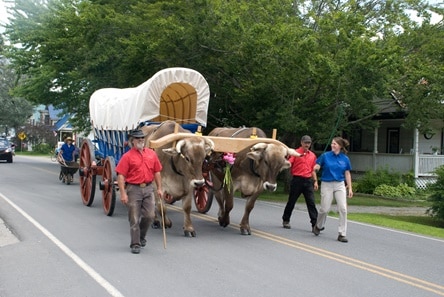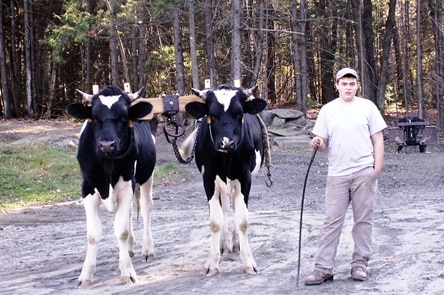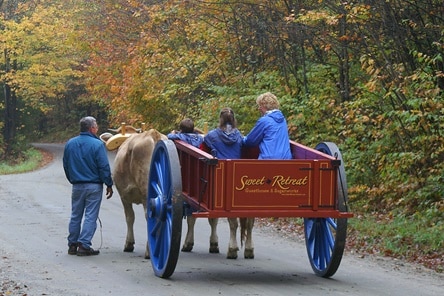Heritage Ox Farm
Sweet Retreat is Home to Heritage Ox Farm and Bright & Lion, our Team from Nova Scotia
Sweet Retreat no longer offers oxen cart or sleigh rides.

We Raise & Train Show Oxen
At Heritage Ox Farm we raise and train show oxen to take to fairs and parades and demonstrations. We started in 2004 with four Brown Swiss calves, Ace, King, Jack, and Joker, from Shelburne Farms in Shelburne, Vermont. In their eleven years with us they became famous for their size, ability and gentleness. Pulling our authentic reproduction Conestoga Covered Wagon, they were a popular attraction at events around New England.
A Family Affair
Our grandchildren, Analiese and Caleb who live nearby, became involved in 4-H and each had several teams during their high school years – Brown Swiss, Dutch Belts, Holsteins, and Shorthorns. Their hard work culminated in success at the Big E in Springfield, Massachusetts.


Lion & Bright—Our Team from Nova Scotia
In 2007, Ray went to Nova Scotia to the Ross Farm Museum to learn how to make ox shoes that protect the oxen’s feet when they are working or walking on frozen ground. While there he was intrigued by the European head yoke style which lashes the yoke to the bony part of the head at the base of the horns. The oxen wear decorative leather face pads and collars with brass bells hanging from the collars. In 2012, Ray and Hannah bought two Hereford-Durham calves, named Bright and Lion, and went to Nova Scotia to get them. With a lot of hard work they have become a great team that can follow many commands and pull people on rides in our wagons and sleigh. As their heads grow, a new yoke has to be made to fit as do the head pads and collars and bells. With their large horns, jeweled pads and collars, and bells ringing, Bright and Lion make a very impressive team when they are all outfitted.
From a Steer to an Oxen
Oxen are male cattle that have been trained to work for people around the world for centuries. To pick a pair of bull calves, you want them to be similar in color, size, weight, and bone structure. As calves they start learning commands and how to walk together as a pair in a neck yoke, sometimes called a bow yoke. Farms have many sizes of yokes to use as the animals grow. At around six months in age the calves are castrated and are called steers. With daily training and a lot of repetition they become “handy” steers. The person doing the training is called the “teamster.” The pair learns to pull, and to change direction using the words “gee” for right, and “haw” for left, and the word ”whoa” to stop. The teamster can then take his or her “team” into competition with others, usually during the summer in events all over New England. When these handy steers turn four years old they are called oxen.


Versatile & Handy Farm Animals
Oxen are capable of a lot of work and when trained well can contribute to the running of the farm – plowing, hauling logs, pulling wagons. They are calm and respond well to the teamster’s instructions. Oxen are very smart and learn routines quickly. They are easy to feed – just hay and grain and lots of water, with salt licks to keep them drinking. Every team has different characteristics, but always the pair becomes inseparable over time and attached to their teamster. They are wonderful animals to have on a farm!

